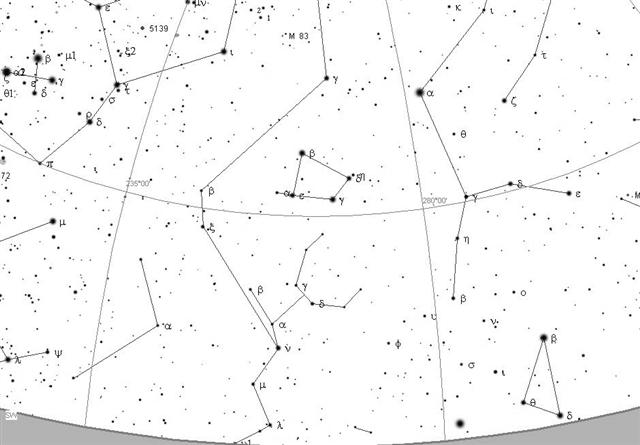|
Alkes |
α Crateris |
4.08 |
18° 02′ S |
10h 57m |
166.6 |
574.6 |
|
Merak |
β Ursa Majoris |
2.34 |
56° 39′ N |
10h 59m |
167.2 |
575.2 |
|
The 12th hour: |
|
Dubhe |
α Ursa Majoris |
1.81 |
62° 01′ N |
11h 01m |
167.7 |
575.7 |
|
Zosma |
δ Leonis |
2.56 |
20° 48′ N |
11h 11m |
170.2 |
578.2 |
|
Coxa |
θ Leonis |
3.33 |
15° 42′ N |
11h 12m |
170.4 |
578.4 |
|
Alula Australe |
ξ Ursa Majoris |
3.79 |
31° 49′ N |
11h 16m |
171.5 |
579.5 |
|
Alula Boreale |
ν Ursa Majoris |
3.49 |
33° 22′ N |
11h 16m |
|
Denebola |
β Leonis |
2.14 |
14° 51′ N |
11h 47m |
179.3 |
587.3 |
|
Alaraph |
β Virginis |
3.59 |
02° 03′ N |
11h 48m |
179.6 |
587.6 |
|
Phekda |
γ Ursa Majoris |
2.41 |
53° 58′ N |
11h 51m |
180.3 |
588.3 |
Looking towards west at 9 p.m. in November 14 in the year 1870 (the date I earlier used for descending Leo) we would from Hanga Roa have been able to see Crater:

Alkes (α Crateris) is here not drawn as a star of Hydra. Above is Corvus and at bottom right is the end triangle of Leo, composed by Denebola (β), Zosma (δ), and Coxa (θ). Between Crater and the Leo triangle is the beginning of Virgo, with Alaraph as β.
The four great stars in Ursa Major are outside the picture to the right.
In the upper left corner we can see the Southern Cross and between it and Hydra is a part of Centaurus.
Connecting stars with glyphs:
| period 13 |
 |
 |
 |
 |
| Ga4-16 (100) |
Ga4-17 |
Ga4-18 |
Ga4-19 (**75) |
| ν Hydrae (164.1) |
|
|
Alkes (166.6), Merak (167.2) |
| period 14 |
 |
 |
 |
| Ga4-20 (*168) |
Ga4-21 |
Ga4-22 |
| Dubhe (167.7) |
|
Zosma (170.2), Coxa (170.4) |
| period 15 |
 |
 |
 |
 |
 |
| Ga4-23 |
Ga4-24 |
Ga4-25 |
Ga4-26 |
Ga4-27 (111) |
| Alula (171.5) |
|
|
|
| period 16 |
 |
 |
 |
| Ga5-1 |
Ga5-2 |
Ga5-3 (114) |
| period 17 |
 |
 |
| Ga5-4 |
Ga5-5 (*180) |
| Denebola (179.3) |
Alaraph (197.6), Phekda (180.3) |
 |
 |
 |
 |
| Ga5-6 |
Ga5-7 (**90) |
Ga5-8 |
Ga5-9 (120) |













